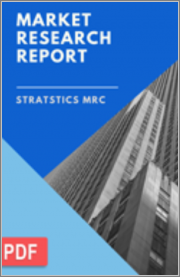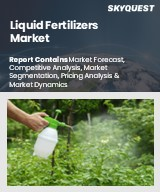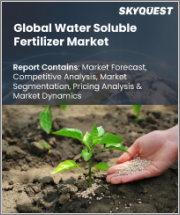
|
시장보고서
상품코드
1324225
세계의 규소 비료 시장 예측(-2030년) : 유형별, 용해성 유형별, 형태별, 용도별 및 지역별 분석Silicon Fertilizer Market Forecasts to 2030 - Global Analysis By Type (Calcium Silicate, Amorphous Silica and Other Types), Soluble Type (Water-soluble, Citrate-soluble and Acid-soluble), Form (Liquid and Solid), Application and By Geography |
||||||
Stratistics MRC에 따르면 규소 비료 세계 시장은 2023년 18억 9,000만 달러로 예측 기간 동안 4.4%의 CAGR로 성장하여 2030년에는 25억 6,000만 달러에 달할 것으로 예상됩니다.
규소 비료에는 화학 비료와 천연 비료가 있습니다. 규소 비료는 수경 재배되는 원예 작물, 화훼 작물, 곡물, 콩, 밀, 사탕수수와 같은 밭 작물에 자주 사용됩니다. 작물의 성장과 수확량을 향상시키기 위해 실리콘은 토양, 땅 또는 식물의 표피 조직에 침착됩니다. 실리콘은 세포벽을 강화하고, 박테리아 및 곰팡이 질병에 대한 저항력을 제공하고, 숙근을 방지하고, 생물학적 및 생물학적 스트레스를 줄임으로써 모든 일년생 및 채소 작물의 성장과 수확량을 지원합니다.
유엔식량농업기구(FAO)에 따르면 2021년부터 2030년까지 세계 농업 생산량은 밀과 기타 조잡한 곡물에서 약 9% 증가할 것으로 예상되며, 이는 같은 경작지 면적에 해당합니다.
시장 역학:
지속가능한 먹거리에 대한 요구 증가
규소 비료 수요 확대에 영향을 미치는 주요 요인으로는 도시화, 유기 농업에 대한 관심 증가, 건강하고 유기농이며 지속가능한 식품에 대한 욕구 등이 있습니다. 지속가능한 식품에 대한 수요 증가는 규소 비료 판매를 주도하는 주요 요인입니다. 독일에서는 유기농 식품에 대한 수요가 증가하면서 산업이 확대될 것으로 보입니다. 인도에서는 밀과 쌀 수확에 대한 수요가 폭발적으로 증가하고 있습니다. 이에 따라 밀과 쌀에 대한 수요와 함께 규소 비료에 대한 수요도 증가하여 물 경제와 밀 수확량을 증가시킬 것입니다. 유기농업의 실천은 전 세계적으로 꾸준히 확대되고 있습니다. 따라서 유기농업의 도입과 함께 밭작물용 규소 비료의 수요도 크게 증가할 것으로 보입니다.
대안 제품 가용성
규소 비료 산업의 주요 과제는 바이오 비료와 천연 비료 시장의 확대입니다. 또한 오염과 작물 수확량 위장은 규소 비료와 관련이 있습니다. 실리카는 PH 값이 높기 때문에 수경 재배에 사용되지 않습니다. 그 결과 화학제품을 사용하지 않는 대안으로 바이오 비료의 사용이 증가하고 있으며 시장 잠재력이 제한되어 있습니다.
원예작물 생산량 증가
원예 작물의 경우, 규소 비료는 작물의 신진대사와 잎의 엽록소 함량을 높이는 동시에 영양 불균형과 금속 독성을 최소화합니다. 또한 염분, 가뭄, 서리와 같은 환경 스트레스에 대한 저항력을 높이고 질병과 해충으로부터 과일과 채소를 보호하여 과일과 채소를 강화합니다. 그 결과, 원예 작물은 환경의 유해한 영향으로부터 보호받으면서 더 높은 수확량으로 생산량을 늘릴 수 있습니다. 규소 비료 시장은 원예 작물 생산 증가로 인해 더욱 확대될 것으로 예상됩니다.
환경에 미치는 영향
규소 비료와 같은 화학 비료는 환경과 그것을 사용하는 사람들에게 해롭다. 규소 비료가 동물이나 사람의 내장에 들어가면 질병이나 사망에 이를 수 있습니다. 결과적으로 이러한 요소들이 시장의 잠재력을 제한하고 있습니다.
COVID-19의 영향
COVID-19 팬데믹으로 인해 2020년 전 세계 각국 정부가 엄격한 봉쇄 규정을 시행하면서 규소 비료 시장의 성장이 저해됐습니다. 그 결과 밭작물 생산, 원예 작물 생산 및 기타 관련 작물 유형은 모두 2020년 첫 몇 달 동안 감소를 경험했습니다. 그러나 2021년에는 작물 생산이 증가하고 봉쇄 관련 규제가 완화되면서 규소 비료 시장이 활성화되었습니다.
예측 기간 동안 액체 부문이 가장 큰 비중을 차지할 것으로 예상
예측 기간 동안 액체 부문이 압도적인 시장 점유율을 차지할 것으로 예상됩니다. 많은 농부들이 액상 규소 비료를 선호하는 이유는 비료 시비가 더 쉽고, 비료가 밭 전체에 균일하게 분포되어 있기 때문입니다. 또한, 액체 규소 비료는 다른 액체 비료 및 농약과 쉽게 혼합할 수 있기 때문에 농부들에게 더 실용적인 선택이기도 합니다.
예측 기간 동안 규산칼륨 부문은 가장 높은 CAGR을 기록할 것으로 예상됨.
규산칼륨은 규소 비료의 일종으로 용해도가 높고 식물에 쉽게 흡수되기 때문에 자주 사용됩니다. 규산칼륨은 부식 방지제, 식물 비료, 콘크리트 치밀화제 등 다양한 용도로 사용됩니다. 목조 주택에서는 난연제로도 사용할 수 있습니다. 또한 식물의 성장과 발육에 필수적인 두 가지 영양소인 규소와 칼륨을 식물에 공급합니다. 이러한 장점으로 인해 이 분야가 확대되고 있습니다.
최대 점유율을 가진 지역:
아시아태평양은 규소 비료 산업에서 가장 큰 점유율을 차지하고 있습니다. 이는 이 지역에 대규모 농업 부문이 있고 인구 증가와 식량 수요 증가로 인해 작물 수확량을 늘리기 위한 효율적인 비료에 대한 수요가 증가하고 있기 때문입니다. 또한 이 지역의 주요 규소 비료 생산자 및 소비자는 중국과 인도를 포함하며 시장 확대를 촉진하고 있습니다.
CAGR이 가장 높은 지역:
유기농 식품과 지속가능한 농업에 대한 수요가 증가함에 따라 북미 규소 비료 시장은 예측 기간 동안 빠르게 성장할 것으로 예상됩니다. 미국, 캐나다, 멕시코 및 기타 국가에서 규소 비료는 자주 사용되며 환경 친화적입니다. 또한 농부들이 규소 비료의 이점을 인식함에 따라 북미 지역에서 규소 비료의 사용이 증가할 것으로 예상됩니다.
무료 맞춤형 서비스:
이 보고서를 구독하는 고객에게는 다음 중 하나의 무료 맞춤화 옵션을 제공합니다:
- 기업 프로필
- 추가 시장 기업의 종합적인 프로파일링(최대 3개사까지)
- 주요 기업 SWOT 분석(3개사까지)
- 지역 세분화
- 고객의 관심에 따른 주요 국가별 시장 추정 및 예측, CAGR(참고: 타당성 검토에 따른)
- 경쟁사 벤치마킹
- 제품 포트폴리오, 지리적 입지, 전략적 제휴를 기반으로 한 주요 기업 벤치마킹
목차
제1장 주요 요약
제2장 서문
- 주요 요약
- 이해관계자
- 조사 범위
- 조사 방법
- 데이터 마이닝
- 데이터 분석
- 데이터 검증
- 조사 접근법
- 조사 소스
- 1차 조사 정보 출처
- 2차 조사 정보 출처
- 가정
제3장 시장 동향 분석
- 성장 촉진요인
- 성장 억제요인
- 기회
- 위협
- 애플리케이션 분석
- 신흥 시장
- COVID-19의 영향
제4장 Porter's Five Forces 분석
- 공급 기업의 교섭력
- 구매자의 교섭력
- 대체품의 위협
- 신규 참여업체의 위협
- 경쟁 기업 간의 경쟁 관계
제5장 규소 비료 세계 시장 : 유형별
- 규산칼슘
- 아몰퍼스 실리카
- 규산 칼륨
- 침전 실리카
- 규산나트륨
- 기타 유형
제6장 규소 비료 세계 시장 : 가용성 유형별
- 수용성
- 구연산 가용성
- 산가용성
제7장 규소 비료 세계 시장 : 형태별
- 액체
- 고체
제8장 규소 비료 세계 시장 : 용도별
- 밭농사
- 수경재배
- 화훼 재배
- 플랜테이션 작물
- 원예작물
- 기타 용도
제9장 규소 비료 세계 시장 : 지역별
- 북미
- 미국
- 캐나다
- 멕시코
- 유럽
- 독일
- 영국
- 이탈리아
- 프랑스
- 스페인
- 기타 유럽
- 아시아태평양
- 일본
- 중국
- 인도
- 호주
- 뉴질랜드
- 한국
- 기타 아시아태평양
- 남미
- 아르헨티나
- 브라질
- 칠레
- 기타 남미
- 중동 및 아프리카
- 사우디아라비아
- 아랍에미리트
- 카타르
- 남아프리카공화국
- 기타 중동 및 아프리카
제10장 주요 발전
- 계약, 파트너십, 제휴, 합작투자
- 인수와 합병
- 신제품 출시
- 사업 확대
- 기타 주요 전략
제11장 기업 개요
- Agripower
- Aries Agro Ltd.
- BASF SE
- Denka Co. Ltd.
- Fertipower Norway
- Fubang Fertilizer
- Fuji Silysia Chem
- Goodearth Resources Sdn Bhd
- Ignimbrite
- Maileduo Fertilizer
- MaxSil
- Multimol Micro Fertilizer
- Plant Tuff Inc.
- Redox Pty Ltd.
- Vision Mark Biotech
- Yara International ASA
- Zhongnong Lvhe Silicon
According to Stratistics MRC, the Global Silicon Fertilizer Market is accounted for $1.89 billion in 2023 and is expected to reach $2.56 billion by 2030 growing at a CAGR of 4.4% during the forecast period. Silicon fertilizer can be either chemical or natural. Silicon fertilizers are frequently used in hydroponically grown horticultural, floricultural, and field crops like cereals, soybeans, wheat, and sugarcane. To improve crop growth and yield, silicon is deposited in soil, land, or plant epidermal tissue. They support the growth and yield of all annual and vegetable crops by helping to strengthen cell walls, providing resistance to bacterial and fungal diseases, preventing lodging, and reducing biotic and abiotic stress.
According to Food and Agriculture Organization (FAO), in 2021-2030, global agricultural production is predicted to increase by roughly 9% for wheat and other coarse grains, which will be on the same area of arable land.
Market Dynamics:
Driver:
Growing need for sustainable foods
Some of the main factors influencing the growth in demand for silicon fertilizers include urbanization, an increase in interest in organic farming, and a desire for healthy, organic, and sustainable foods. The growing demand for sustainable food products is the primary factor driving silicon fertilizer sales. The industry will expand as a result of Germany's increasing demand for organic foods. In India, there is an explosive increase in demand for wheat and rice harvests. As a result, the demand for silicon fertilizer increases along with the demand for wheat and rice, which together help boost the water economy and wheat yield. The practice of organic farming is steadily growing throughout the world. So, with the adoption of organic farming, there would be a significant increase in the demand for silicon fertilizers for field crops.
Restraint:
Availability of alternative products
The main challenges for the silicon fertilizer industry are the expanding bio- and natural fertilizer markets. Furthermore, pollution and falsified crop yields have been linked to silicon fertilizers. Silica is not used in hydroponic crop cultivation due to its high PH level. As a result, the market's potential is being restricted by the growing use of biofertilizers as chemical-free substitutes.
Opportunity:
Rising horticulture production
For horticulture crops, silicon fertilizer increases crop metabolism and leaf chlorophyll content while minimizing nutrient imbalances and metal toxicity. It fortifies fruits and vegetables by increasing their resistance to environmental stresses like salt, drought, and frost, as well as by shielding them from diseases and pests. As a result, the horticulture crop expands its production with higher yields while also being protected from the damaging effects of the environment. The market for silicon fertilizer is anticipated to expand further as a result of the rising production of horticultural crops.
Threat:
Environmental consequences
Chemical fertilizers, such as silicon fertilizers, are harmful to the environment and those who use them. When silicon fertilizers enter an animal's or human's internal organs, they can lead to illness and even death. As a result, these elements are limiting the market's potential.
COVID-19 Impact:
Due to strict lockdown regulations put in place by governments all over the world in 2020 as a result of the COVID-19 pandemic, the silicon fertilizer market's growth was hampered. Field crop production, horticulture crop production, and other related crop types all experienced a decline in the first few months of 2020 as a result. However, in 2021, there was an increase in crop production, which fueled the market for silicon fertilizer due to the ease of lockdown-related regulation.
The liquid segment is expected to be the largest during the forecast period
During the forecast period, the liquid segment is anticipated to hold a dominant market share. Many farmers prefer silicon fertilizer in liquid form because it is simpler to apply and results in a more even distribution of the fertilizer throughout the field. Furthermore, liquid silicon fertilizers are also a more practical choice for farmers because they mix easily with other liquid fertilizers or pesticides.
The potassium silicate segment is expected to have the highest CAGR during the forecast period
Potassium silicate is a form of silicon fertilizer that is frequently used because of its high solubility and easy absorption by plants. Potassium silicates have a wide range of applications, including as a corrosion inhibitor, a plant fertilizer, and a concrete densifier. In wooden homes, it serves as a fire retardant as well. Additionally, it provides plants with silicon and potassium, two nutrients essential to the growth and development of plants. Such advantages are boosting the segment's expansion.
Region with largest share:
With a significant share of the market, Asia-Pacific is regarded as the largest region in the silicon fertilizer industry. This is because the area has a sizable agricultural sector, a growing population, and rising food demand, which has led to a greater demand for efficient fertilizers to increase crop yields. Additionally, major producers and consumers of silicon fertilizers in the region include China and India, which is boosting market expansion.
Region with highest CAGR:
Due to rising demand for organic food and sustainable agriculture, the North American market for silicon fertilizers is anticipated to expand rapidly in the forecast timeline. In the United States, Canada, Mexico, and other countries, silicon fertilizer is frequently used and is environmentally friendly. Furthermore, as farmers become more aware of their advantages, the use of silicon fertilizers is anticipated to rise in the North American region.
Key players in the market:
Some of the key players profiled in the Silicon Fertilizer Market include: Agripower, Aries Agro Ltd. , BASF SE, Denka Co. Ltd., Fertipower Norway, Fubang Fertilizer, Fuji Silysia Chem, Goodearth Resources Sdn Bhd, Ignimbrite, Maileduo Fertilizer, MaxSil, Multimol Micro Fertilizer, Plant Tuff Inc., Redox Pty Ltd. , Vision Mark Biotech, Yara International ASA and Zhongnong Lvhe Silicon.
Key Developments:
In July 2023, BASF and Zhejiang Guanghua Technology Co.,Ltd. (KHUA) have signed a Letter of Intent (LoI) for the supply of Neopentyl Glycol (NPG) from BASF's Zhanjiang Verbund site to KHUA. This agreement marks a significant milestone in the long-term partnership between both parties.
In June 2023, BASF is inaugurating the expansion of its Innovation Campus Shanghai, China, consisting of two new research and development (R&D) buildings. The company has invested a total of €280 million since 2012 to its Innovation Campus Shanghai, thus enhancing its innovation capabilities and better support its customers in China and across Asia.
In May 2023, Denka Company Limited has decided to conduct joint research with Transform Materials LLC, a global microwave plasma technology provider, to establish its technology for realizing the low-carbon production of acetylene. The signing ceremony was held on May 23, 2023.
Types Covered:
- Calcium Silicate
- Amorphous Silica
- Potassium Silicate
- Precipitated Silica
- Sodium Silicate
- Other Types
Soluble Types Covered:
- Water-soluble
- Citrate-soluble
- Acid-soluble
Forms Covered:
- Liquid
- Solid
Applications Covered:
- Field Crops
- Hydroponics
- Floriculture
- Plantation Crops
- Horticultural Crops
- Other Applications
Regions Covered:
- North America
- US
- Canada
- Mexico
- Europe
- Germany
- UK
- Italy
- France
- Spain
- Rest of Europe
- Asia Pacific
- Japan
- China
- India
- Australia
- New Zealand
- South Korea
- Rest of Asia Pacific
- South America
- Argentina
- Brazil
- Chile
- Rest of South America
- Middle East & Africa
- Saudi Arabia
- UAE
- Qatar
- South Africa
- Rest of Middle East & Africa
What our report offers:
- Market share assessments for the regional and country-level segments
- Strategic recommendations for the new entrants
- Covers Market data for the years 2021, 2022, 2023, 2026 and 2030
- Market Trends (Drivers, Constraints, Opportunities, Threats, Challenges, Investment Opportunities, and recommendations)
- Strategic recommendations in key business segments based on the market estimations
- Competitive landscaping mapping the key common trends
- Company profiling with detailed strategies, financials, and recent developments
- Supply chain trends mapping the latest technological advancements
Free Customization Offerings:
All the customers of this report will be entitled to receive one of the following free customization options:
- Company Profiling
- Comprehensive profiling of additional market players (up to 3)
- SWOT Analysis of key players (up to 3)
- Regional Segmentation
- Market estimations, Forecasts and CAGR of any prominent country as per the client's interest (Note: Depends on feasibility check)
- Competitive Benchmarking
- Benchmarking of key players based on product portfolio, geographical presence, and strategic alliances
Table of Contents
1 Executive Summary
2 Preface
- 2.1 Abstract
- 2.2 Stake Holders
- 2.3 Research Scope
- 2.4 Research Methodology
- 2.4.1 Data Mining
- 2.4.2 Data Analysis
- 2.4.3 Data Validation
- 2.4.4 Research Approach
- 2.5 Research Sources
- 2.5.1 Primary Research Sources
- 2.5.2 Secondary Research Sources
- 2.5.3 Assumptions
3 Market Trend Analysis
- 3.1 Introduction
- 3.2 Drivers
- 3.3 Restraints
- 3.4 Opportunities
- 3.5 Threats
- 3.6 Application Analysis
- 3.7 Emerging Markets
- 3.8 Impact of Covid-19
4 Porters Five Force Analysis
- 4.1 Bargaining power of suppliers
- 4.2 Bargaining power of buyers
- 4.3 Threat of substitutes
- 4.4 Threat of new entrants
- 4.5 Competitive rivalry
5 Global Silicon Fertilizer Market, By Type
- 5.1 Introduction
- 5.2 Calcium Silicate
- 5.3 Amorphous Silica
- 5.4 Potassium Silicate
- 5.5 Precipitated Silica
- 5.6 Sodium Silicate
- 5.7 Other Types
6 Global Silicon Fertilizer Market, By Soluble Type
- 6.1 Introduction
- 6.2 Water-soluble
- 6.3 Citrate-soluble
- 6.4 Acid-soluble
7 Global Silicon Fertilizer Market, By Form
- 7.1 Introduction
- 7.2 Liquid
- 7.3 Solid
8 Global Silicon Fertilizer Market, By Application
- 8.1 Introduction
- 8.2 Field Crops
- 8.3 Hydroponics
- 8.4 Floriculture
- 8.5 Plantation Crops
- 8.6 Horticultural Crops
- 8.7 Other Applications
9 Global Silicon Fertilizer Market, By Geography
- 9.1 Introduction
- 9.2 North America
- 9.2.1 US
- 9.2.2 Canada
- 9.2.3 Mexico
- 9.3 Europe
- 9.3.1 Germany
- 9.3.2 UK
- 9.3.3 Italy
- 9.3.4 France
- 9.3.5 Spain
- 9.3.6 Rest of Europe
- 9.4 Asia Pacific
- 9.4.1 Japan
- 9.4.2 China
- 9.4.3 India
- 9.4.4 Australia
- 9.4.5 New Zealand
- 9.4.6 South Korea
- 9.4.7 Rest of Asia Pacific
- 9.5 South America
- 9.5.1 Argentina
- 9.5.2 Brazil
- 9.5.3 Chile
- 9.5.4 Rest of South America
- 9.6 Middle East & Africa
- 9.6.1 Saudi Arabia
- 9.6.2 UAE
- 9.6.3 Qatar
- 9.6.4 South Africa
- 9.6.5 Rest of Middle East & Africa
10 Key Developments
- 10.1 Agreements, Partnerships, Collaborations and Joint Ventures
- 10.2 Acquisitions & Mergers
- 10.3 New Product Launch
- 10.4 Expansions
- 10.5 Other Key Strategies
11 Company Profiling
- 11.1 Agripower
- 11.2 Aries Agro Ltd.
- 11.3 BASF SE
- 11.4 Denka Co. Ltd.
- 11.5 Fertipower Norway
- 11.6 Fubang Fertilizer
- 11.7 Fuji Silysia Chem
- 11.8 Goodearth Resources Sdn Bhd
- 11.9 Ignimbrite
- 11.10 Maileduo Fertilizer
- 11.11 MaxSil
- 11.12 Multimol Micro Fertilizer
- 11.13 Plant Tuff Inc.
- 11.14 Redox Pty Ltd.
- 11.15 Vision Mark Biotech
- 11.16 Yara International ASA
- 11.17 Zhongnong Lvhe Silicon



















